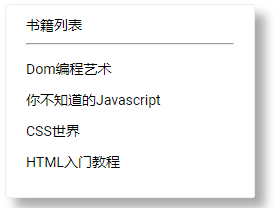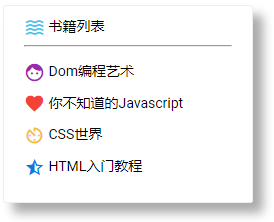需求
先假设我们需要实现如下效果,并将其封装成一个组件,当然目的并不是要真的封装组件,而是在这个过程中学习 插槽 的使用以及优化的思路哈:

<template>
<div>
<div>{{ title }}</div>
<hr>
<div>
<div v-for="(item, i) in List" :key="i">{{ item }}</div>
</div>
</div>
</template>
然后在父组件中这样调用就 ok 了:
<template>
<custom-list :title="title" :List="books" />
</template>
<script>
import CustomList from './custom-list.js';
export default {
components: { CustomList },
data() {
return {
title: '书籍列表',
books: ['Dom编程艺术', '你不知道的Javascript', 'CSS世界', 'HTML入门教程'],
};
},
};
</script>
Emmm。。乍一看似乎没有任何毛病,甚至数据变化了也是可以满足要求的。
然而,这样就够了吗?需求总是善变的,比如说,有一天又要满足如下效果呢?

插槽
这个时候就到我们的 插槽 登场了。插槽允许我们将子组件中的内容分发到父组件,由父组件决定子组件要渲染的内容。
普通插槽
还是以上述组件为例,我们需要将子组件中 title的内容分发出去,由父组件将内容传进来。此时我们可以这样修改子组件:
<template>
<div>
<div>
<slot></slot>
</div>
<hr>
<div>
<div v-for="(item, i) in List" :key="i">{{ item }}</div>
</div>
</div>
</template>
然后在父组件中调用:
<template>
<custom-list :List="books">
<span><icon type="waves"> 书籍列表</span>
</custom-list>
</template>
<script>
import CustomList from './custom-list.js';
export default {
components: { CustomList },
data() {
return {
title: '书籍列表',
books: ['Dom编程艺术', '你不知道的Javascript', 'CSS世界', 'HTML入门教程'],
};
},
};
</script>
这样的话,父组件中包裹的内容就会替代 <slot> 标签,所以最终的渲染结果就是这样的:
<template>
<div>
<div>
<span><icon type="waves"> 书籍列表</span>
</div>
<hr>
<div>
<div v-for="(item, i) in List" :key="i">{{ item }}</div>
</div>
</div>
</template>
顺便提一嘴:在 <slot> 标签中也是可以放置内容的,如:<slot> 标题 </slot>, 这表示插槽的默认内容,只有当父组件没有通过插槽传递内容的时候,才会显示该默认内容。
同理我们的 content 的内容也是需要分发出去的,于是我们再修改:
<template>
<div>
<div>
<slot></slot>
</div>
<hr>
<slot></slot>
</div>
</template>
这样一来又有问题了:我们定义了两个 怎么去区分它们的内容呢,总不能靠书写顺序吧?这显然是不靠谱的。于是,就有了 具名插槽。
具名插槽
顾名思义就是带名字的插槽,便于多个插槽之间的区分。然后我们继续修改:
<template>
<div>
<div>
<slot name="title"></slot>
</div>
<hr>
<slot name="content"></slot>
</div>
</template>
给每个插槽定义一个 name 属性,然后我们在父组件传值的时候带上对应插槽的 name 就行了。
<template>
<custom-list>
<template v-slot:title>
<span><icon type="waves"> 书籍列表</span>
<template>
<template v-slot:content>
<div>
<div v-for="(item, i) in book" :key="i">
<icon :type="item.icon">{{ item.name }}
</div>
</div>
</template>
</custom-list>
</template>
<script>
import CustomList from './custom-list.js';
export default {
components: { CustomList },
data() {
return {
title: '书籍列表',
books: [
{ name: 'Dom编程艺术',icon: 'face' },
{ name: '你不知道的Javascript', icon: 'favorite' },
{ name: 'CSS世界', icon: 'av_timer'},
{ name: 'HTML入门教程', icon: 'star_half' },
],
};
},
};
</script>
在向具名插槽提供内容的时候,我们可以在一个
<template>元素上使用v-slot指令,并以v-slot的参数的形式提供其名称。
这下可好了,连数据都不用传了,List 在子组件根本用不到,数据直接在父组件中就渲染了,而且每次使用这个组件的时候都要写一遍 v-for,那为什么不把 v-for 写在子组件中呢?这样就只需要写一次了。
那我们再来修改子组件:
<template>
<div>
<div>
<slot name="title"></slot>
</div>
<hr>
<div>
<div v-for="(item, i) in List">
<slot name="item"></slot>
</div>
</div>
</div>
</template>
这样又有问题了:我要显示 item 但是 item 是子组件中的数据,当父组件通过 v-slot 传递内容进来的时候,<slot>{{ item }}</slot> 的内容就会被传进来的内容替换了。这咋搞呢?思考一下,如果我们将数据给父组件,在父组件中显示不就解决了么?那么这个时候就要轮到 作用域插槽 登场了。
作用域插槽
作用域插槽允许我们将子组件的数据传给父组件,这不正好解决了上面的问题么?下面我们再调整子组件
<template>
<div>
<div>
<slot name="title"></slot>
</div>
<hr>
<div>
<div v-for="(item, i) in List">
<slot name="item" :row="item"></slot>
</div>
</div>
</div>
</template>
此时我们将每个 item 的值通过 row 属性传给了 <slot>, 然后我们在父组件中取出这个值:
<template>
<custom-list>
<template v-slot:title>
<span><icon type="waves"> 书籍列表</span>
<template>
<!--实际传的数据格式为: { row:{ name: xx, icon: xx } },所以这里可以使用结构赋值-->
<template v-slot:item="{ row }">
<icon :type="row.icon">{{ row.name }}
</template>
</custom-list>
</template>
这样我们的组件就完成了,不仅灵活性更高,代码健壮性也更好。 总得来说,插槽还是很好用的,特别是在封装组件的时候。